Blog
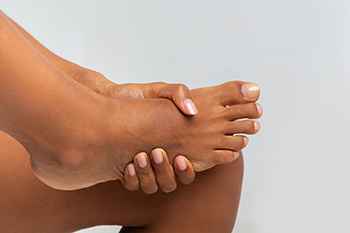
Pain on the top of the foot can be a frustrating issue, often linked to several possible causes, including tendonitis, stress fractures, or arthritis. Tendonitis occurs when the tendons in the foot become inflamed due to overuse or wearing improper footwear, resulting in sharp, throbbing pain. Stress fractures, which are small cracks in the bones, usually develop from repetitive stress and can cause consistent discomfort, especially with increased activity. Arthritis, particularly osteoarthritis, can lead to pain when bone spurs form in the joints. A podiatrist will first ask about your medical history and perform a physical exam to assess whether the pain is sharp, dull, or worsened by certain activities. An X-ray or an MRI scan may be ordered to detect the cause. Ignoring this type of foot pain can lead to further problems. If you have unexplained pain on the top of the foot, it is suggested that you schedule an appointment with a podiatrist for an exam and treatment options.
Foot Pain
Foot pain can be extremely painful and debilitating. If you have a foot pain, consult with one of our podiatrists from Foot and Ankle Clinics, PA. Our doctors will assess your condition and provide you with quality foot and ankle treatment.
Causes
Foot pain is a very broad condition that could be caused by one or more ailments. The most common include:
- Bunions
- Hammertoes
- Plantar Fasciitis
- Bone Spurs
- Corns
- Tarsal Tunnel Syndrome
- Ingrown Toenails
- Arthritis (such as Gout, Rheumatoid, and Osteoarthritis)
- Flat Feet
- Injury (from stress fractures, broken toe, foot, ankle, Achilles tendon ruptures, and sprains)
- And more
Diagnosis
To figure out the cause of foot pain, podiatrists utilize several different methods. This can range from simple visual inspections and sensation tests to X-rays and MRI scans. Prior medical history, family medical history, and any recent physical traumatic events will all be taken into consideration for a proper diagnosis.
Treatment
Treatment depends upon the cause of the foot pain. Whether it is resting, staying off the foot, or having surgery; podiatrists have a number of treatment options available for foot pain.
If you have any questions, please feel free to contact our offices located in Woodbury, West St. Paul, and Edina, MN . We offer the newest diagnostic and treatment technologies for all your foot care needs.

Ankle pain can arise from various causes that affect your mobility and quality of life. Common sources of ankle pain include sprains, strains, fractures, and conditions like osteoarthritis or rheumatoid arthritis. An ankle sprain occurs when the ligaments, which connect bones, are overstretched or torn. A strain involves damage to muscles or tendons in the ankle joint. Fractures are breaks in the bone, often resulting from trauma. Other causes, like gout or infections, can lead to severe swelling and pain. Flatfoot disorder and rheumatoid arthritis are also linked to ankle pain, often worsening over time. Managing ankle pain early is important to avoid further injury. A podiatrist can diagnose these conditions through physical exams and imaging studies, followed by a treatment plan to reduce pain and prevent complications. If you are suffering from ankle pain, it is suggested that you schedule an appointment with a podiatrist for a diagnosis and treatment.
Ankle pain can be caused by a number of problems and may be potentially serious. If you have ankle pain, consult with one of our podiatrists from Foot and Ankle Clinics, PA. Our doctors will assess your condition and provide you with quality foot and ankle treatment.
Ankle pain is any condition that causes pain in the ankle. Due to the fact that the ankle consists of tendons, muscles, bones, and ligaments, ankle pain can come from a number of different conditions.
Causes
The most common causes of ankle pain include:
- Types of arthritis (rheumatoid, osteoarthritis, and gout)
- Ankle sprains
- Broken ankles
- Achilles tendonitis
- Achilles tendon rupture
- Stress fractures
- Bursitis
- Tarsal tunnel syndrome
- Plantar fasciitis
Symptoms
Symptoms of ankle injury vary based upon the condition. Pain may include general pain and discomfort, swelling, aching, redness, bruising, burning or stabbing sensations, and/or loss of sensation.
Diagnosis
Due to the wide variety of potential causes of ankle pain, podiatrists will utilize a number of different methods to properly diagnose ankle pain. This can include asking for personal and family medical histories and of any recent injuries. Further diagnosis may include sensation tests, a physical examination, and potentially x-rays or other imaging tests.
Treatment
Just as the range of causes varies widely, so do treatments. Some more common treatments are rest, ice packs, keeping pressure off the foot, orthotics and braces, medication for inflammation and pain, and surgery.
If you have any questions, please feel free to contact our offices located in Woodbury, West St. Paul, and Edina, MN . We offer the newest diagnostic and treatment technologies for all your foot care needs.
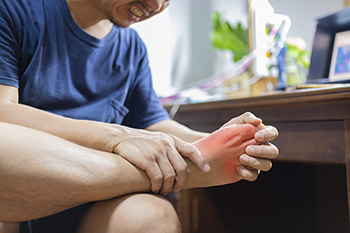
Gout is a form of arthritis caused by the accumulation of uric acid crystals in the joints. It often affects the feet and results in severe pain, redness, swelling, and stiffness. Gout commonly affects the big toe, but it can also target the ankles and any of the many other foot joints. Gout can be triggered by a diet high in purines, which are found in red meats and certain seafood. Alcohol consumption, obesity, and certain medications are other common factors. People with a kidney condition or who take diuretics for blood pressure control are at a higher risk. During a gout flare-up, the affected area may become hot and extremely sensitive to touch, making everyday activities challenging. Although gout is not curable, it can be managed with the help of a podiatrist through guidance on minimizing future flare-ups. This may include addressing risk factors, such as dietary habits, and prescribing medication to lower uric acid levels. If you are experiencing flare ups of gout, it is suggested that you schedule an appointment with a podiatrist.
Gout is a foot condition that requires certain treatment and care. If you are seeking treatment, contact one of our podiatrists from Foot and Ankle Clinics, PA. Our doctors will treat your foot and ankle needs.
What Is Gout?
Gout is a type of arthritis caused by a buildup of uric acid in the bloodstream. It often develops in the foot, especially the big toe area, although it can manifest in other parts of the body as well. Gout can make walking and standing very painful and is especially common in diabetics and the obese.
People typically get gout because of a poor diet. Genetic predisposition is also a factor. The children of parents who have had gout frequently have a chance of developing it themselves.
Gout can easily be identified by redness and inflammation of the big toe and the surrounding areas of the foot. Other symptoms include extreme fatigue, joint pain, and running high fevers. Sometimes corticosteroid drugs can be prescribed to treat gout, but the best way to combat this disease is to get more exercise and eat a better diet.
If you have any questions please feel free to contact our offices located in Woodbury, West St. Paul, and Edina, MN . We offer the newest diagnostic and treatment technologies for all your foot and ankle needs.
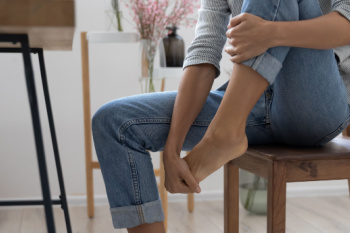
Symptoms of arthritis in the toes can vary from mild discomfort to significant pain and swelling. One of the early signs is stiffness, especially in the big toe joint, which can limit movement and make walking difficult. As the condition progresses, toe pain often flares during activities like standing or walking and may persist even after resting. Swelling is another common symptom of arthritis in the toes, making them difficult to bend. You might also notice redness or warmth due to inflammation, in addition to deformities such as bunions or hammertoes, which can affect foot function. In some cases, arthritis leads to creaking sounds in the joints, referred to as crepitus. This can worsen during cold or damp weather and further limit mobility. A podiatrist can evaluate your condition and recommend appropriate ways to help manage pain and improve foot function. If you are experiencing symptoms of arthritis in the toes, it is suggested that you schedule an appointment with a podiatrist.
Toe pain can disrupt your daily activities. If you have any concerns, contact one of our podiatrists of Foot and Ankle Clinics, PA. Our doctors can provide the care you need to keep you pain-free and on your feet.
What Causes Toe Pain?
Most severe toe pain is caused due to a sports injury, trauma from dropping something heavy on the toe, or bumping into something rigid. Other problems can develop over time for various reasons.
Toe pain can be caused by one or more ailments. The most common include:
- Trauma
- Sports injury
- Wearing shoes that are too tight
- Arthritis
- Gout
- Corns and calluses
- Hammertoe
- Bunions
- Blisters
- Ingrown toenails
- Sprains
- Fractures (broken bones)
- Dislocations
When to See a Podiatrist
- Severe pain
- Persistent pain that lasts more than a week
- Signs of infection
- Continued swelling
- Pain that prevents walking
Diagnosis
In many cases the cause of toe pain is obvious, but in others, a podiatrist may want to use more advanced methods to determine the problem. These can range from simple visual inspections and sensation tests to X-rays and MRI scans. Prior medical history, family medical history, and any recent physical traumatic events will all be taken into consideration for a proper diagnosis.
Treatment
Treatments for toe pain and injuries vary and may include shoe inserts, padding, taping, medicines, injections, and in some cases, surgery. If you believe that you have broken a toe, please see a podiatrist as soon as possible.
If you have any questions please feel free to contact our offices located in Woodbury, West St. Paul, and Edina, MN . We offer the newest diagnostic tools and technology to treat your foot and ankle needs.
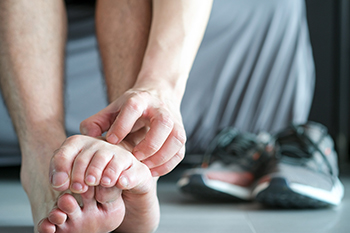
Athlete's foot, or tinea pedis, is a common fungal infection that affects the skin on the feet. It is caused by fungi that thrive in warm, moist environments, such as sweaty shoes or communal showers. Symptoms of athlete’s foot include itching, redness, and a burning sensation, often between the toes or on the soles of the feet. The skin may become dry, flaky, and cracked, which can lead to discomfort and potential secondary bacterial infections. Keeping the feet clean and dry, changing socks regularly, and wearing breathable footwear can aid in recovery and prevent recurrence. For persistent or severe cases, it is suggested you schedule an appointment with a podiatrist for a tailored treatment plan.
Athlete’s foot is an inconvenient condition that can be easily reduced with the proper treatment. If you have any concerns about your feet and ankles, contact one of our podiatrists from Foot and Ankle Clinics, PA. Our doctors will treat your foot and ankle needs.
Athlete’s Foot: The Sole Story
Athlete's foot, also known as tinea pedis, can be an extremely contagious foot infection. It is commonly contracted in public changing areas and bathrooms, dormitory style living quarters, around locker rooms and public swimming pools, or anywhere your feet often come into contact with other people.
Solutions to Combat Athlete’s Foot
- Hydrate your feet by using lotion
- Exfoliate
- Buff off nails
- Use of anti-fungal products
- Examine your feet and visit your doctor if any suspicious blisters or cuts develop
Athlete’s foot can cause many irritating symptoms such as dry and flaking skin, itching, and redness. Some more severe symptoms can include bleeding and cracked skin, intense itching and burning, and even pain when walking. In the worst cases, Athlete’s foot can cause blistering as well. Speak to your podiatrist for a better understanding of the different causes of Athlete’s foot, as well as help in determining which treatment options are best for you.
If you have any questions please feel free to contact our offices located in Woodbury, West St. Paul, and Edina, MN . We offer the newest diagnostic and treatment technologies for all your foot and ankle needs.
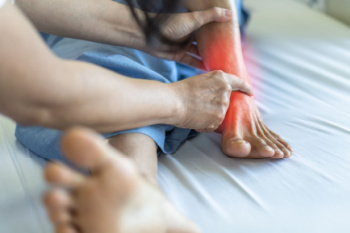
Tarsal tunnel syndrome, also known as tibial nerve dysfunction or posterior tibial nerve neuralgia, is caused by compression of the tibial nerve as it passes through the tarsal tunnel on the inner side of the ankle. This nerve compression leads to pain, tingling, and numbness in the foot. Individuals with tarsal tunnel syndrome often experience symptoms on the sole and the toes, particularly the arch area. In severe cases, the discomfort may be aggravated by standing or walking. Tarsal tunnel syndrome may cause difficulty in completing daily activities. If you have pain in this area of your foot, it is suggested that you consult a podiatrist who can accurately diagnose and treat this condition.
Tarsal tunnel syndrome can be very uncomfortable to live with. If you are experiencing tarsal tunnel syndrome, contact one of our podiatrists of Foot and Ankle Clinics, PA. Our doctors can provide the care you need to keep you pain-free and on your feet.
Tarsal Tunnel Syndrome
Tarsal tunnel syndrome, which can also be called tibial nerve dysfunction, is an uncommon condition of misfiring peripheral nerves in the foot. The tibial nerve is the peripheral nerve in the leg responsible for sensation and movement of the foot and calf muscles. In tarsal tunnel syndrome, the tibial nerve is damaged, causing problems with movement and feeling in the foot of the affected leg.
Common Cause of Tarsal Tunnel Syndrome
- Involves pressure or an injury, direct pressure on the tibial nerve for an extended period of time, sometimes caused by other body structures close by or near the knee.
- Diseases that damage nerves, including diabetes, may cause tarsal tunnel syndrome.
- At times, tarsal tunnel syndrome can appear without an obvious cause in some cases.
The Effects of Tarsal Tunnel Syndrome
- Different sensations, an afflicted person may experience pain, tingling, burning or other unusual sensations in the foot of the affected leg.
- The foot muscles, toes and ankle become weaker, and curling your toes or flexing your foot can become difficult.
- If condition worsens, infections and ulcers may develop on the foot that is experiencing the syndrome.
A physical exam of the leg can help identify the presence of tarsal tunnel syndrome. Medical tests, such as a nerve biopsy, are also used to diagnose the condition. Patients may receive physical therapy and prescriptive medication. In extreme cases, some may require surgery.
If you have any questions please feel free to contact our offices located in Woodbury, West St. Paul, and Edina, MN . We offer the newest diagnostic and treatment technologies for all your foot and ankle needs.

Blisters are small fluid-filled bubbles that typically form on the skin as a result of friction or pressure, often from wearing new or tight shoes. These bubbles develop when repeated rubbing causes the top layers of skin to separate. This allows fluid to accumulate in the space created. While friction is the most common cause of blisters, they can also arise from burns, sunburn, insect bites, and certain medical conditions. Symptoms include a raised area of skin filled with clear fluid or blood, along with redness, pain, and itching. Blisters can be painful and may become infected if not properly treated. Popping a blister is not recommended as it can lead to infection. A podiatrist can safely treat blisters on the feet, ensuring that any underlying causes are identified and addressed. If you have a problematic blister on the foot, it is suggested that you schedule an appointment with a podiatrist for an exam and treatment options.
Blisters may appear as a single bubble or in a cluster. They can cause a lot of pain and may be filled with pus, blood, or watery serum. If your feet are hurting, contact one of our podiatrists of Foot and Ankle Clinics, PA. Our doctors can provide the care you need to keep you pain-free and on your feet.
Foot Blisters
Foot blisters are often the result of friction. This happens due to the constant rubbing from shoes, which can lead to pain.
What Are Foot Blisters?
A foot blister is a small fluid-filled pocket that forms on the upper-most layer of the skin. Blisters are filled with clear fluid and can lead to blood drainage or pus if the area becomes infected.
Symptoms
(Blister symptoms may vary depending on what is causing them)
- Bubble of skin filled with fluid
- Redness
- Moderate to severe pain
- Itching
Prevention & Treatment
In order to prevent blisters, you should be sure to wear comfortable shoes with socks that cushion your feet and absorb sweat. Breaking a blister open may increase your chances of developing an infection. However, if your blister breaks, you should wash the area with soap and water immediately and then apply a bandage to the affected area. If your blisters cause severe pain it is important that you call your podiatrist right away.
If you have any questions, please feel free to contact our offices located in Woodbury, West St. Paul, and Edina, MN . We offer the newest diagnostic and treatment technologies for all your foot care needs.
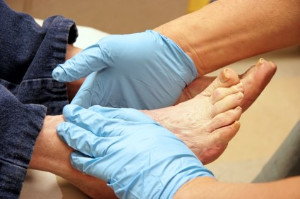
Diabetic foot care is crucial for avoiding complications and maintaining foot health. Do regularly inspect your feet for cuts, blisters, or changes in skin color, as diabetes can impair sensation and delay healing. Clean your feet daily with mild soap and water, and keep them dry, especially between the toes, to prevent infections. Always wear well-fitting, supportive shoes to avoid blisters and sores. Regular visits to a podiatrist can help detect potential issues early. Do not walk barefoot, as this increases the risk of injury and infection. Avoid using hot water bottles or heating pads on your feet, as reduced sensation can lead to burns. Do not self-treat or attempt to cut corns or calluses, as this can cause injury. If you have diabetes, it is suggested that you regularly visit a podiatrist who can help you to manage this condition.
Diabetic foot care is important in preventing foot ailments such as ulcers. If you are suffering from diabetes or have any other concerns about your feet, contact one of our podiatrists from Foot and Ankle Clinics, PA. Our doctors can provide the care you need to keep you pain-free and on your feet.
Diabetic Foot Care
Diabetes affects millions of people every year. The condition can damage blood vessels in many parts of the body, especially the feet. Because of this, taking care of your feet is essential if you have diabetes, and having a podiatrist help monitor your foot health is highly recommended.
The Importance of Caring for Your Feet
- Routinely inspect your feet for bruises or sores.
- Wear socks that fit your feet comfortably.
- Wear comfortable shoes that provide adequate support.
Patients with diabetes should have their doctor monitor their blood levels, as blood sugar levels play such a huge role in diabetic care. Monitoring these levels on a regular basis is highly advised.
It is always best to inform your healthcare professional of any concerns you may have regarding your feet, especially for diabetic patients. Early treatment and routine foot examinations are keys to maintaining proper health, especially because severe complications can arise if proper treatment is not applied.
If you have any questions please feel free to contact our offices located in Woodbury, West St. Paul, and Edina, MN . We offer the newest diagnostic and treatment technologies for all your foot and ankle needs.
Blog Archives
- 2025
- 2024
- 2023
- 2022
- 2021
- 2020


